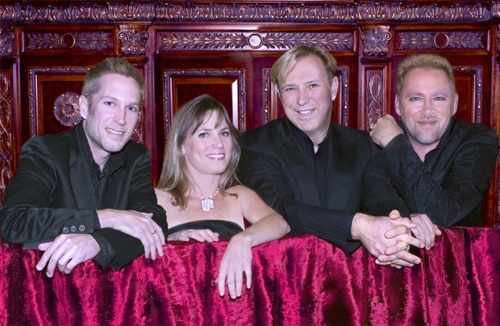Illuminating the masters…
Burlingame’s Kohl Mansion finished out their chamber music season this Sunday, April 22 with the Rosetti Quartet and the return of a native son. Cellist Eric Gaenslen was born and raised in Burlingame, and began cello there in the first grade, although Julliard was his “finishing” school. He has played with the Rossetti quartet since 1999 and they have been frequent visitors to his hometown with numerous appearances on the Kohl Mansion stage.
On Sunday they polished three gems of the quartet repertoire: Mozart’s stunning homage to Haydn, the creator of the quartet form, Shostakovich’s lament for his wife, Nina, and the “Harp” quartet from Beethoven’s middle period.
I had come for the Shostakovich, but their vision of Mozart’s early foray took my breath away. The final quartet of a set of six, the C Major “Dissonance” opened with hesitant cello strokes painting a thin ground. Viola and violins stepped in to build a dissonant chord, and then they swelled to a sound that would have been sumptuous in a less difficult mode. Mozart brought them close to melodic line, then shied back into dissonance, toying with emotions that yearned but could not resolve.
And then after a pause they stepped into major, and into the light and the melodic sunshine that was to become Mozart’s trademark. The Andante cantabile was both perfectly gentle and a vehicle for deeper truths, and I enjoyed seeing the performers throw themselves into their parts.
First violinist and founder Henry Gronnier brought hefty presence and liquid fingering. Co-founder Thomas Diener sought the dramatic center, with a flair that over-spilled his viola’s notes. He cheated in and out, waving his viola to the phrases like a pop vocalist with a mike. Seated in Kohl Mansion’s intimate hall, I was nearly able to read the music over his shoulder. But what I noticed most were his boots! His pointed toes sparkled crimson with black leather uppers, and he kicked and waved them to coax extra emotion out of his strings. I was not surprised to find out that Mozart played that viola part at his own quartet’s premiere.
Cellist Gaenslen supplied the red meat with deep-dredged notes and a slow vibrato like crickets on a hot summer night. And violinist Sara Parkins was their glue, melding, doubling, harmonizing and completing statements.
 And then Dimitri Shostakovich! Though his Quartet No. 8 is better known for its sinister four note motif, Shostakovich’s String Quartet No. 7 is a marvel in miniature. Clocking in at only 13 minutes, it is succinct without sacrificing its ability to immerse us in a world of grief, totalitarian Communism and hospitals. Its themes are underlain by fear and loss, its tone icy. Gronnier opened with a sprightly motif with “wrong” notes, manic in intent and richly engraved on the silence. The others entered with soft questions and three short notes, which may have been the source of the famous “knock on the door” of Quartet No. 8.
And then Dimitri Shostakovich! Though his Quartet No. 8 is better known for its sinister four note motif, Shostakovich’s String Quartet No. 7 is a marvel in miniature. Clocking in at only 13 minutes, it is succinct without sacrificing its ability to immerse us in a world of grief, totalitarian Communism and hospitals. Its themes are underlain by fear and loss, its tone icy. Gronnier opened with a sprightly motif with “wrong” notes, manic in intent and richly engraved on the silence. The others entered with soft questions and three short notes, which may have been the source of the famous “knock on the door” of Quartet No. 8.
In the Lento Parkins created an uncertain ground with distorted arpeggios, and the others skated in, a little eerie. Here is his grief, sick and searching.
But then came an explosive anger, abrupt chords and a return to the first movement theme, deep bowed and spat out. After furious unison chords they slowed and quieted, then returned to the beginning. This time their treatment was gentle, a touch of resignation, mystery and ashes.
In Kai Christiansen’s excellent notes (and he lectures before every concert), he describes Beethoven’s String Quartet No. 10 as “perfect…and devilish to play.” Yet the Rossetti made it seem all too easy. They opened on a perfect chord, then climbed long and gentle steps to arrive in a warm plateau where Beethoven reveals his broad orchestral vision. In the Lento we were treated to deeply felt playing, which lightened in mood into lovely arpeggios. Like Brahms, it was as if Beethoven were trying to describe a world so hopeful, it strangely leaves one in tears.
But the scherzo was volcanic and thrilling, and hearing it performed by this group in that resonant hall was about as good as it gets.
I can’t wait for next year’s series.
—Adam Broner
The Rossetti Quartet, from left: cellist Eric Gaenslen, violinists Sara Parkins and Henry Gronnier, and violist Thomas Diener.
